
How to Bulk Up: The Complete Guide for Skinny Guys
I was underweight well into my twenties. I would read guides about how to build muscle, and I would try them, but they wouldn’t work. They would urge me to bulk slowly and leanly, filling me with a fear of fat gain. But I wasn’t scared of gaining fat. That wasn’t my problem.
I wanted to build muscle fast—as fast as I possibly could. I didn’t care if my gains were perfectly lean, I just didn’t want to be skinny anymore. So, I ignored the conventional wisdom. I bulked more aggressively, gaining 20 pounds in 3 months, and to my great surprise, I didn’t even gain a noticeable amount of body fat.
Shortly after that, I came into contact with Marco, a strength coach helping college, professional, and Olympic athletes bulk up during their off-seasons. He was as naturally skinny as I was. He taught me how to bulk the proper way. I gained another 25 pounds in another 3 months.
Since then, we’ve helped 15,000 other skinny guys replicate those same results. In this article, we’ll teach you how you can do it, too.
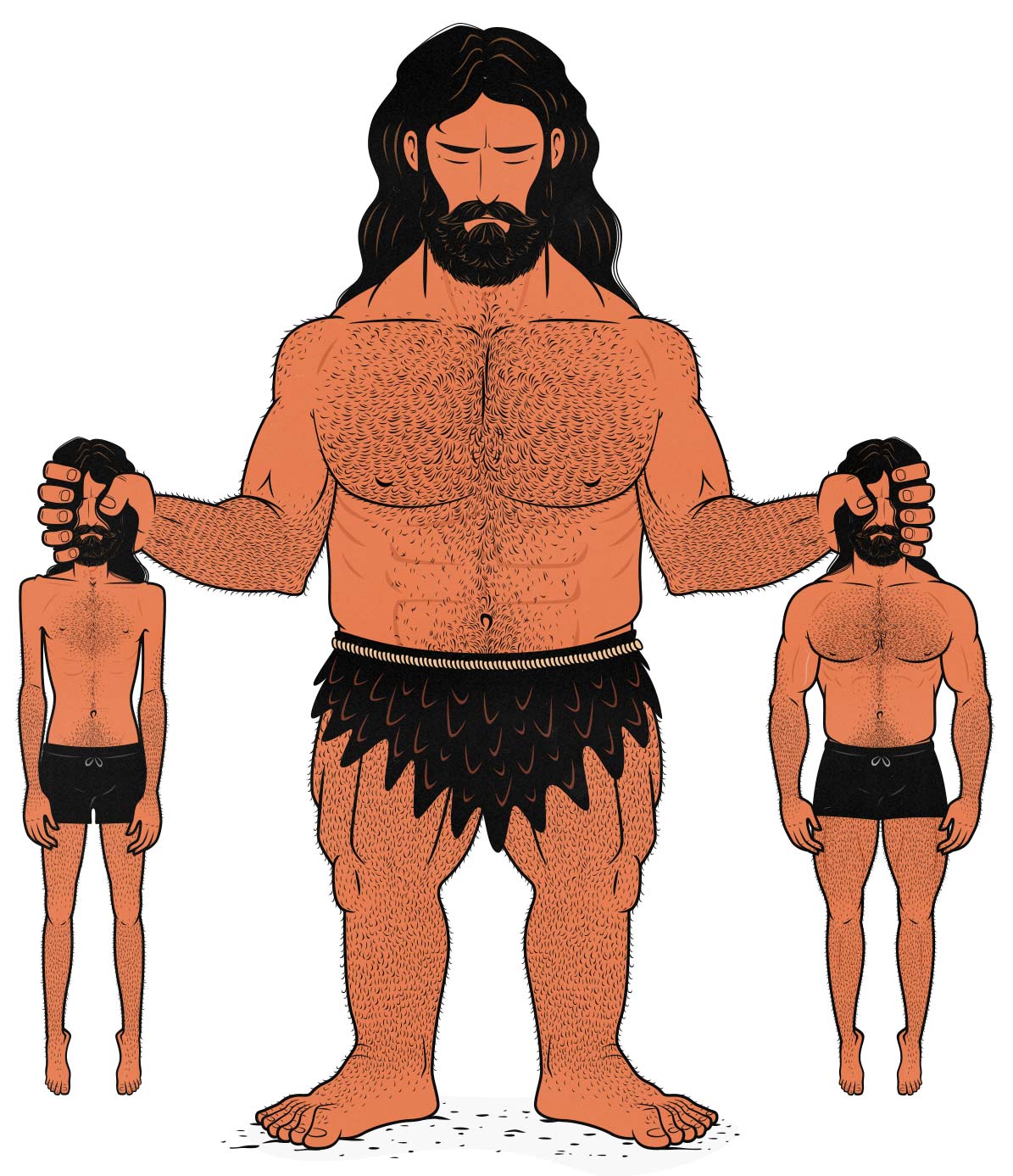
Introduction
As he makes his way through the jungle of muscle growth, a skinny man may feel like a small, fragile bird in a world of much larger beasts. The obvious solution is to become a man again, rediscovering the wonder of human movement and growth, using that wonder to kindle the spark of strength within. The less obvious solution is to become an eagle.
Understanding the Skinny Body Type
The term “skinny” refers to people with lower-than-average amounts of muscle mass and body fat. This leaves them unencumbered by excess weight, allowing them to move with a lightness of step, evading the notice of enemies.

Some individuals are predisposed to skinniness, their bodies primed to resist the accumulation of mass. This can be due to a number of factors:
- Natural Leanness: Body fat serves as an energy reserve for the body. Most men can get their energy by burning off their bellies, whereas skinny guys must get their energy by filling them.
- Skinny guys often have faster metabolisms. Some of this is due to higher activity levels, including subconscious movements like pacing and fidgeting. But some many us burn more calories while lying quietly in bed, doing nothing at all (full explanation). This is a double-edged sword. It helps us stay lean, but it also makes it harder for us to eat enough food to build muscle.
- Smaller Stomachs: The average human stomach comfortably holds about 1–1.5 litres of food and fluid. Skinny people often have a smaller stomach capacity, forcing us to eat smaller meals more often.
- Low Appetite: Many people have a genetic variant that gives them a rapacious appetite, making it difficult to resist the allure of calorie-rich foods. The opposite can be true as well. Many of us skinny guys are relatively uninterested in food.
- Gut Health: If our digestive systems aren’t functioning properly, it’s more difficult to consume enough calories and nutrients to fuel muscle growth. For a common example, Irritable bowel syndrome (IBS) can make it quite a bit harder to bulk up.
- The Shadow: If a skinny guy is repressing his desire to be strong, he must first acknowledge and embrace that desire. He must also recognize that building muscle is a long process that requires dedication and perseverance.
Skinniness often stems from a natural tendency, but our bodies are capable of adapting to the burdens we place upon them. You can stimulate muscle growth by challenging your muscles. Your stomach can adapt to hold more food. Your gut can be strengthened. You can overcome your metabolism through a process known as bulking.
How to Bulk
Skinny guys are remarkably good at building muscle. Once we learn how to eat enough food to support muscle growth, we tend to build muscle faster than average.
The process of bulking is simple in theory but difficult in practice. You need the proper combination of a good bulking diet and rigorous hypertrophy training. The first step is to create a calorie surplus. That is, to consume more food than your body needs, giving you extra energy to build muscle.
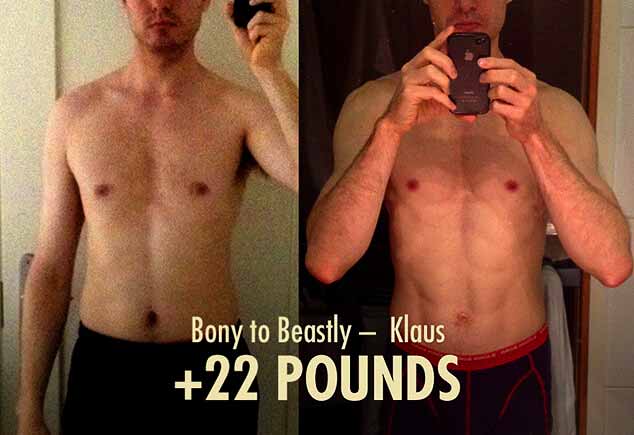
But consuming more food is not enough. Left by itself, a calorie surplus will lash out in its loneliness, engulfing you in a gelatinous cube. Thus, you must also engage in resistance training, challenging your muscles and inciting them to grow bigger. With enough stimulation, your muscles will greedily consume the surplus, leaving little to be stored as fat.
Bulk up with food and weights, gaining muscle by adding plates.
Most skinny guys can gain around 30 pounds of muscle in their first year of lifting weights. You need to eat enough food to support that muscle growth. I suggest a surplus of about 500 extra calories per day (study). A slower pace may lead to leaner muscle growth, allowing you to bulk for longer. A faster pace often yields faster muscle growth. But remember, any calories your muscles can’t consume will be stored as fat.
I advise a rate of weight gain of around one pound per week. You can gain anywhere from 0.5-2 pounds per week. Faster rates of weight gain can work quite well for taller, skinnier beginners. Slower rates often work better for skinny-fat guys.
If you aren’t gaining weight, it’s because your calorie intake isn’t exceeding your needs. Keep one eye on the scale, the other on your gut, and adjust your caloric intake as you see fit.
The Workout Program
How to Train for Muscle Size
There are two potential paths you could venture down, both gnarled and veering into one another, hopelessly intertwining. The first path is heavier training, where the focus is on gaining maximal strength. The other path is hypertrophy training, which emphasizes gaining muscle mass (study). Either way, you’ll get bigger and stronger. But hypertrophy training will get you bigger faster.
These are the key components of our workout program:
- A full-body workout routine. Train every muscle every workout. We must not let a single opportunity for growth go to waste.
- Compound exercises are the foundation. Think of big exercises like goblet squats, push-ups, pulldowns, and Romanian deadlifts.
- Isolation exercises add the finishing touches. Choose exercises for the muscles you want to grow the fastest, like biceps curls for your biceps.
- Do 8-12 reps per set. This repetition range is proven to stimulate muscle growth effectively. You must choose a weight you can lift for the designated number of reps, with good form, but that also challenges you towards the end of each set.
- Take 90-120 seconds of rest between sets. This will give your muscles almost enough time to recover for the next set. In this case, almost enough is more than enough.
- Do 2-5 sets per exercise. The ideal number of sets varies based on your goals and training experience. As you acclimatize to lifting weights, you’ll recover faster, allowing you to benefit from doing more sets. So, begin with two sets per exercise, gradually working your way up to as many as five.
- Lift with power. Accelerate the weight up, putting your best effort into each repetition. Then, lower it down slowly and under control.
- Train three times a week, resting 2–3 days between each workout. This training frequency provides both the stimulation and the time your muscles need to grow.
- Remember to fuel your body with a calorie surplus and proper nutrition. This will provide the building blocks necessary for muscle growth, allowing you to lift more weight every workout.
- Remember progressive overload. Stronger muscles need to be challenged by heavier weights to continue growing.
- In six weeks, pause to gaze upon the progress you’ve made. This routine will guide you through those first six weeks. You may need another routine after that. Reflect and decide.
Lift with conviction, lower with control, and be patient. The weight will be worth it.
Shane Duquette
Exercise Selection
This program is for beginners, so we recommend beginning with beginner variations. These simpler exercise variations stimulate just as much muscle growth, but they make it much easier to lift with good technique, building a foundation of strength and stability.
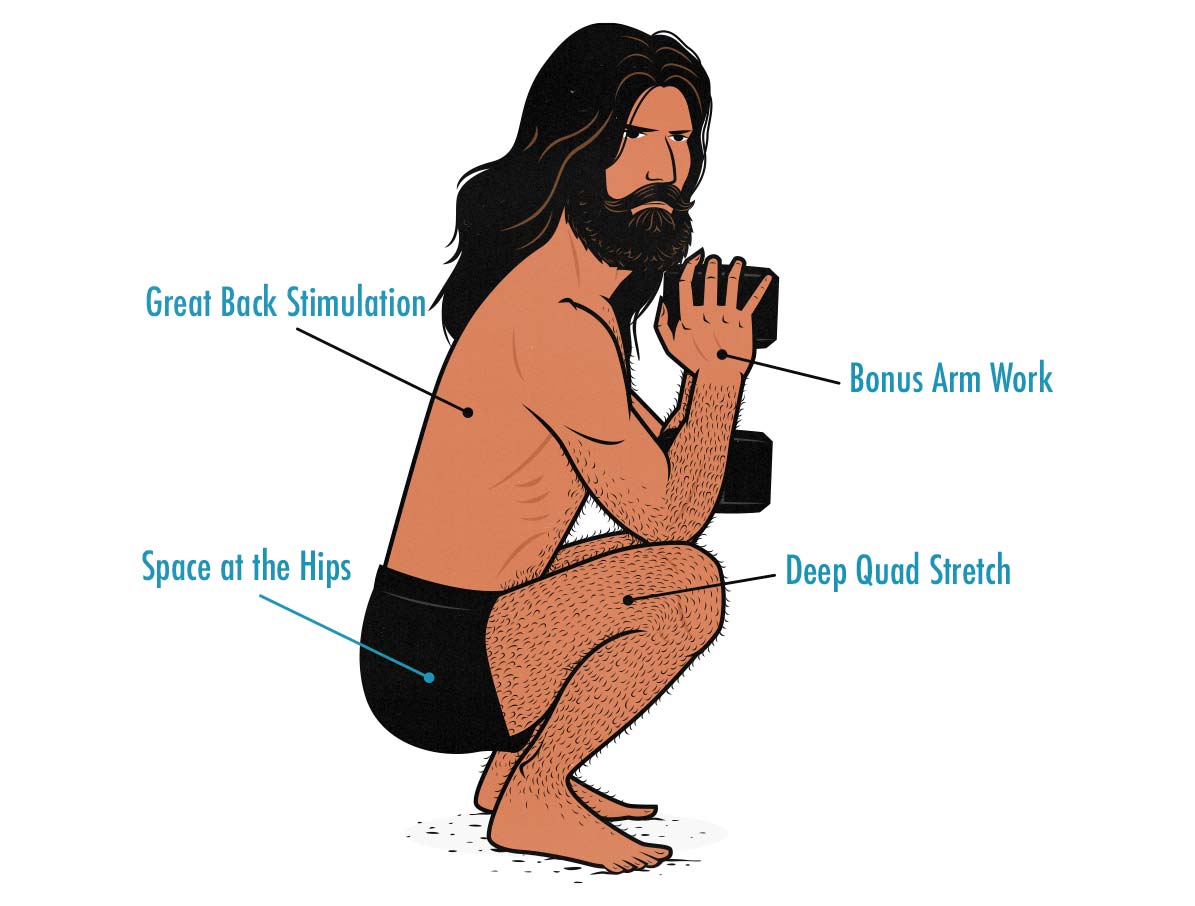
Consider the humble goblet squat. It pushes your quads just as hard as the back squat, but it does a much better job of teaching skinny beginners to engage their cores and maintain upright torsos. It also strengthens postural muscles like the upper back and serratus.
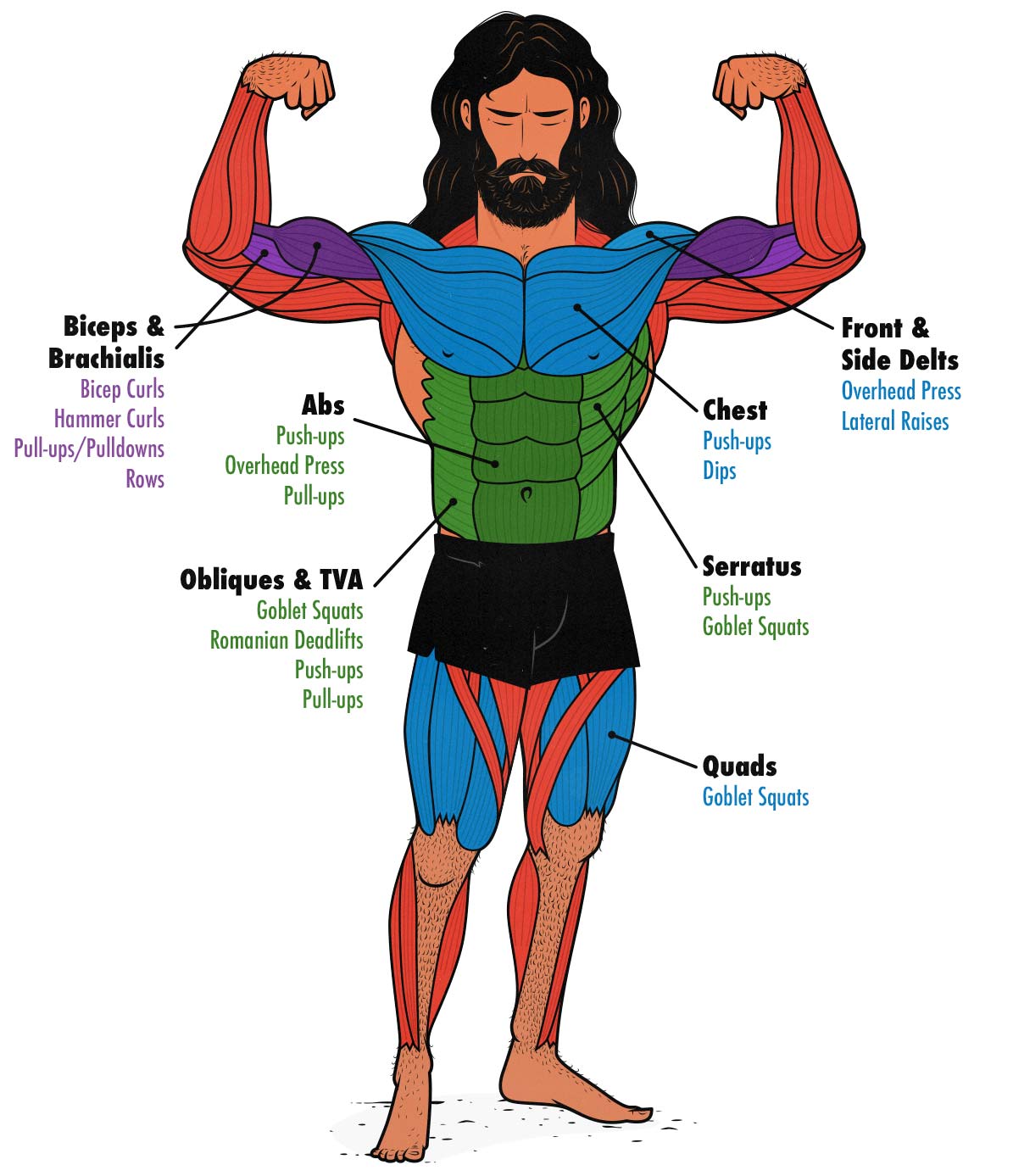
Or compare the push-up against the bench press. Both are equally good for building a bigger chest, but the push-up does a better job of strengthening the postural muscles of the core, and it stimulates more growth in secondary muscle groups, such as the serratus (study).
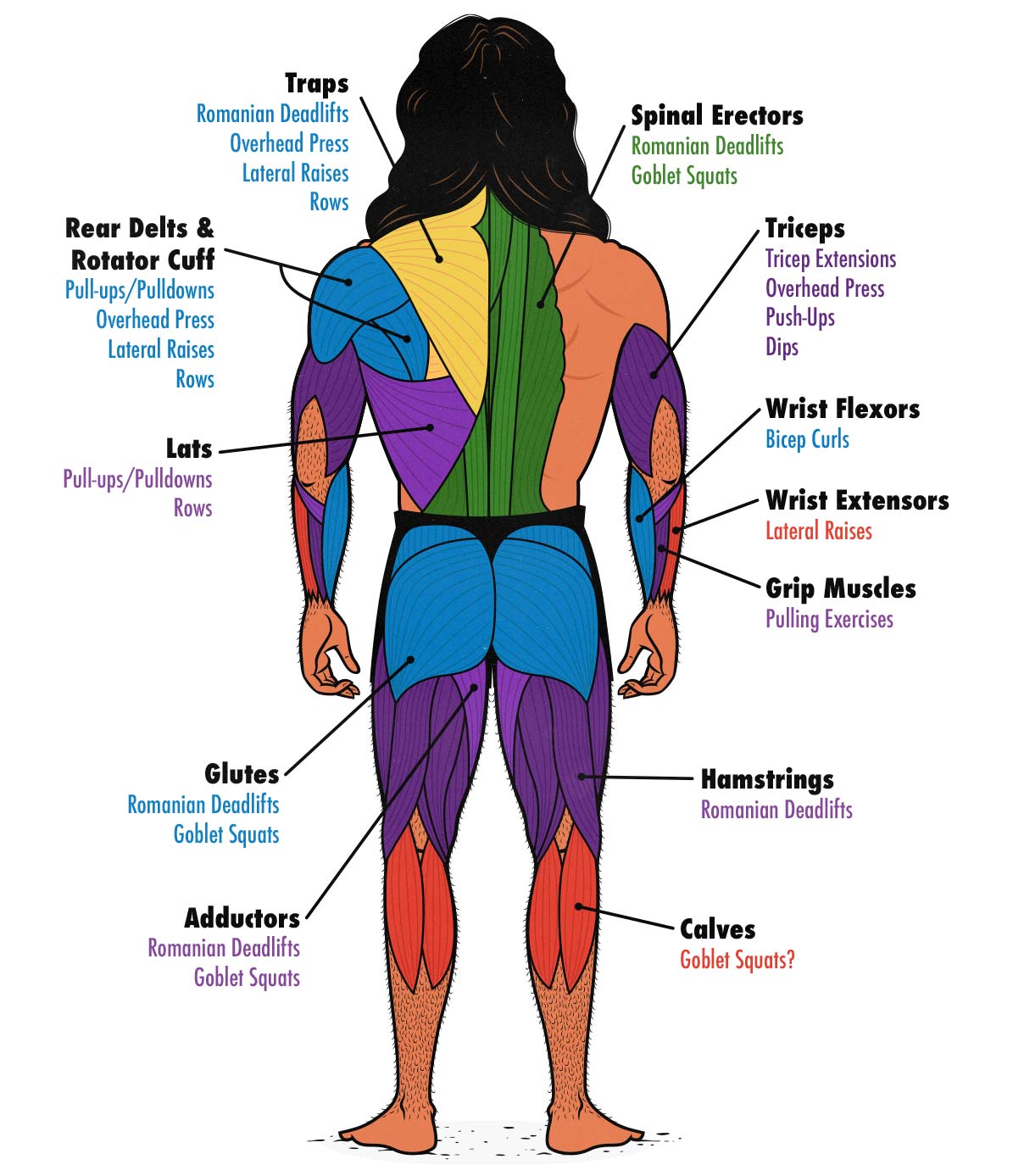
We’ll use at least one compound exercise for every major movement pattern. They’ll combine together to form a balanced workout routine.
- Goblet squats target your quads and upper back, while Romanian deadlifts target your hamstrings, lower back, and glutes.
- Push-ups target your chest, shoulders, and triceps, while dumbbell rows target your back and biceps.
- Bicep curls, tricep extensions, and lateral raises give the finishing touches to muscles that are not as easily stimulated by compound exercises.
The Workout Routine
Gargoyles are terrifying stone statues with sharp claws and snarling faces, serving as a warning to any who dare approach. By following this workout routine, your muscles will grow as tough as the stone from which the gargoyles were hewn, and your strength will be as feared as the beasts themselves. The world will tremble at the sight of you, just as it trembles before the gargoyles.

This 3-day full-body split allows for adequate rest and recovery between workouts. Doing 8-12 reps per set and 2-5 sets per exercise gives you the ideal training volume for muscle growth. We begin with two sets in the first week, giving you time to acclimatize to the workout routine.
After the first week, you can add one set per week, to a maximum of five, to the exercises you’re most drawn to. This will give you a foundation of balance from which you can pursue your own unique goals.
Workout Day 1
- Goblet Squats: 2–5 sets of 8-12 reps
- Push-ups: 2–5 sets of as many reps as possible (AMRAP)
- Dumbbell Rows: 2–5 sets of 8-12 reps
- Bicep Curls: 2–5 sets of 8-12 reps
- Tricep Extensions: 2–5 sets of 8-12 reps
Workout Day 2
- Romanian Deadlifts: 2–5 sets of 8-12 reps
- Pulldowns: 2–5 sets of 8-12 reps
- One-Arm Overhead Press: 2–5 sets of 8-12 reps
- Lateral Raises: 2–5 sets of 8-12 reps
- Hammer Curls: 2–5 sets of 8-12 rep
Workout Day 3
- Goblet Squats: 2–5 sets of 8-12 reps
- Push-ups (or dips): 2–5 sets of AMRAP
- Dumbbell Rows: 2–5 sets of 8-12 reps
- Bicep Curls: 2–5 sets of 8-12 reps
- Tricep Extensions: 2–5 sets of 8-12 reps
To stir the growth of your muscles, you must be unafraid to challenge them. Hurl weights upon yourself! Make your muscles work until they cry out in protest! Only then will they rise to the occasion, growing thick enough to bear the burden you have placed upon them.
You should be able to complete the target number of repetitions (8-12) with good form but struggle to complete the final repetition. If you can’t get 8 repetitions in your final set, reduce the weight. When you can do more than 12 repetitions in your first set and more than 8 in your final set, add weight.
The Bulking Diet
Nutrition Principles
There’s more to bulking than a calorie surplus. You also need to provide your body with the right balance of macronutrients (protein, carbohydrates, fat, and fibre) and micronutrients (vitamins and minerals). You need to cultivate digestive fortitude. You need to eat on a consistent schedule.
Here‘s the diet I recommend for this bulking program:
- Strive for a daily calorie surplus of around 250-1000 calories. Keep an eye on your weekly weight gain. If you aren’t gaining weight, you need to consume more food. You need to consume more calories than you burn.
- Consume 1 gram of protein per pound of body weight each day. Protein is the building block of muscle, so it’s important to consume enough of it. This will give you a little bit more than you need. Try to have some protein in every meal. Keep a loose tally of your total intake.
- Include plenty of carbohydrates in your diet. They provide you with fibre, vitamins, minerals, and energy to fuel your workouts. They should make up a significant portion of your daily caloric intake. You do not need to track them.
- Eat healthy fats. Think of sources like fatty fish, nuts, seeds, avocados, and extra-virgin olive oil. You don’t need to track your fat intake.
- Feast on fibre. Fibre helps regulate digestion and promotes a healthy gut, all of which is crucial while bulking—especially when you’re bulking fast! Fibre also helps regulate blood sugar levels and reduces the risk of heart disease. Try to include a source of fibre in every meal.
- Hide away your junk food like a thief hiding away his treasure. You shouldn’t have junk in the first place, but if you do, don’t get caught with it.
- Eat often. If your stomach is half the normal size, eat as a halfling does. Don’t skip your second breakfast, second lunch, or second dinner.
Fill your plate with hearty portions of lean meats, ripe fruits, and fibrous grains. Let the flavours of roasted fish and grilled vegetables mingle upon your tongue. Let the aromas of simmering stews and fiery chilis fill your nostrils. Drink deeply of milk and life, for we are bulking!
How to Eat More Calories
I could evoke the comfort of a full belly and the satisfaction of a body well-fed. I could remind you that bulking is a world of abundance and delight. But that would misunderstand the condition of the skinny man who is stuffed to the brim and struggling to consume more calories.

Here are some ways to eat more calories more comfortably:
- Prepare. Plan your bulking meals for the week ahead and have all ingredients at hand. Cook up huge portions of food and store the leftovers for later. Fill your pantry with bulking foods that won’t spoil, such as trail mix and beef jerky.
- Eat often. Smaller, more frequent feedings can increase your calorie intake without leaving you feeling over-full. Nibble on nutritious foods like nuts, dried fruit, dark chocolate, Greek yogurt, jerky, and hard-boiled eggs.
- Don’t skip meals! If your body is a castle, then think of each surplus calorie as a stone and each meal as an opportunity to lay more stones.
- Drink deeply of calorie-rich beverages. A thirst for thickness cannot be quenched by water, tea, or diet soda, so seek out heartier drinks like bulking smoothies, protein shakes, peasant milk, and plant-based milk.
- Revel in the goodness of healthy fats. Incorporate cheeses, avocados, and nuts into your diet to increase the caloric density of your meals. Cook with healthy oils like avocado or olive oil.
- Feast on nutritious starchy carbs. Foods like sweet potatoes, brown rice, and oats are all excellent for building muscle (full explanation). And, of course, without fruits, your bulk will be fruitless.
- Adorn your meals with tasty toppings. Sprinkle calorie-dense ingredients like grated cheese, nuts, seeds, and dark chocolate chips onto your meals to increase their nutritional worth.
- Use calorie-dense dips and condiments like mayonnaise, tahini, nut butter, honey, and olive oil.
- Don’t forget fibre. Make sure you get enough of it through foods like whole grains, fruits, and vegetables. It’s filling per calories, yes, but it also improves digestion.
- Fermented foods are friends to your gut. Foods like yogurt, kefir, and kimchi can improve gut health and support digestion.
- Go on walks after big meals. Such wanderings promote the movement of food through your digestive tract and encourage the release of digestive hormones, increasing the rate of gastric emptying and preventing the buildup of gas and stool in your intestines.
As a final recourse, if all else has failed you, you may seek the support of a mass gainer supplement. Choose that weight gainer wisely and with trepidation, and drink it sparingly.
Three Bulking Recipes
I’ve used my extensive knowledge of nutrition and cooking to create three unique bulking recipes. They are loaded with calories, protein, carbs, fats, fibre, and all the essential building blocks you need to build a strong and healthy body.
The Salmon of Knowledge
This is a hearty and nutritious one-pan bulking meal inspired by the Irish legend of Fionn mac Cumhail. The story goes that there was once a famed poet who spent seven long years in pursuit of a magical salmon, a fish that was said to carry all the world’s knowledge within its flesh. When the poet finally caught the salmon, he gave it to his servant, Fionn, with instructions to cook it but not to taste a single morsel.

Fionn tended the flames and turned the salmon on the spit, but when he touched the fish to see if it was done, he seared his thumb on a drop of its hot fat. Without thinking, he sucked on the burned finger.
When Fionn presented the cooked salmon to the poet, the master saw a gleam of wisdom in the boy’s eyes. He grew wary, asking if Fionn had tasted the fish. The boy explained what had happened, and the poet gave him the rest of the fish to eat.
And so it was that Fionn became a wise man with the knowledge of the world at his fingertips. For the rest of his days, he could draw upon this deep knowledge by biting his thumb. He became the leader of the Fianna, the legendary heroes of Irish myth, wielding the salmon’s wisdom as a sword against the forces of darkness.
Ingredients:
- 4 salmon fillets (6 oz each)
- 4 cloves of garlic, minced
- 4 tbsp olive oil
- 2 tbsp lemon juice
- Salt and pepper to taste
- 2 medium sweet potatoes, diced
- 2 cups of green beans
Instructions:
- Preheat oven to 400°F. Line a baking sheet with parchment paper.
- In a small bowl, mix together the garlic, olive oil, lemon juice, salt and pepper.
- Place the salmon fillets on the baking sheet and brush the mixture evenly over each fillet.
- Add the diced sweet potatoes around the salmon fillets.
- Sprinkle salt and pepper over the sweet potatoes.
- Add the green beans to the pan and mix everything together.
- Bake for 20-25 minutes, or until the salmon is cooked through and the sweet potatoes are tender.
Serving size: 1 salmon fillet and 1/4 of the sweet potatoes and green beans mixture. Each serving contains 570 calories, 45 grams of carbs, 40 grams of fat, and 41 grams of protein.
Druid’s Mix
This is a nutritious, high-calorie snack mix inspired by Eron and the Druid. The story goes that there was once a skinny young man named Eron. One day, while drinking at the local tavern, he overheard hushed whispers of a decrepit old druid who could milk the very earth herself, condensing her power into a potion that granted strength and longevity to whoever drank it.
That very night, Eron set out on a journey through the primeval jungle, hacking his way through the shadows and the serpents, until at last, he saw the druid’s tower rising up from the jungle like a twisted finger pointing to the sky. The old druid inside was hunched and wrinkled, with a long black beard that crawled about his ankles.
Eron stood tall, his heart pounding in his chest. “I may be little more than skin and bone, but I have the heart of a warrior. I am willing to do whatever it takes to bulk up.”
“Very well,” said the druid, holding out a vial filled with a black liquid. “But beware, the strength this potion grants is not meant for mortal man. Give the potion to a wild beast, dry the meat, and mix it with fruits and seeds gathered from the jungle. Eat a small portion every morning. That small surplus will give your muscles the energy they need to grow.”
But Eron, driven by the hubris in his warrior’s heart, couldn’t wait to be muscular. He took the vial and drank it in one gulp. As the potion took hold, he lost his sense of self within his rapidly growing body. He grew immensely strong but was filled with an insatiable desire for more. He roamed the forest, devouring all in his path, becoming the terror of the woods, a man-beast that struck fear into the hearts of all.
The druid, knowing the danger the man-beast posed, set a clever trap. The trap was a large net woven from vines and dusted with melatonin. When the man-beast approached the druid’s tower, the druid activated the trap, and the net fell upon the beast, entangling it and sending it into a deep slumber.

The druid slow-dried the man-beast’s flesh, mixed it with fruits and nuts gathered from the jungle’s trees, and ate a small portion every morning, using the small calorie surplus to build muscle at a reasonable pace.
With each passing day, the druid grew stronger and more attractive, his wrinkles smoothing out as his skin inflated with muscle. The druid’s secret to longevity was never revealed, but it was said he lived to be a hundred years old, strong and vital until the very end.
Ingredients:
- 100g beef jerky
- 100g trail mix (nuts, seeds, dried cherries, and dark chocolate)
Instructions:
- In a bowl, mix together the beef jerky and trail mix
- Store it in an airtight container
- Enjoy it as a snack throughout the day
200 grams of Druid’s Mix has a total of around 800 calories and 40 grams of protein.
Milk Smoothie
Some research shows that bananas pair better with oats, milk, and protein powder than with fruits and berries. This recipe leans into that. It’s rich in all the essential amino acids your body needs to repair and build muscle. It’s also high in calcium, which will strengthen your bones and help you contract your muscles.

Ingredients:
- 1 cup whole milk
- 1 scoop protein powder
- 1 banana
- 1 tablespoon honey
- 1/4 cup rolled oats
- 1/4 teaspoon ground cinnamon
Instructions:
- Add all ingredients to a blender.
- Blend until smooth.
- Pour into a glass and enjoy.
This milk smoothie has approximately 400 calories and 50g of protein.
Sleeping for Muscle Growth
Sleeping gives your body the rest it needs to repair and grow. When you awaken, you’ll find yourself sore and thirsty but also filled with renewed vigour and strength.
Here’s how to get enough good sleep:
- Get physical exercise: Regular exercise can help you fall asleep faster and sleep more deeply. But try to finish your workout at least a couple of hours before bed.
- Get regular exposure to natural light: Spend time outside during the day to regulate your sleep-wake cycle. I recommend going on a brisk 25-minute walk after breakfast.
- Stick to a schedule: Try to go to bed and wake up at the same time every day, even on weekends. This helps regulate your body’s internal clock, making it easier to fall asleep at night and wake up in the morning.
- Create a bedtime routine: Establish a relaxing routine, such as reading a book or taking a warm bath, to signal to your body that it’s time to wind down.
- Try to avoid screens for at least one hour before bed: The blue light emitted by electronic devices can interfere with your body’s natural sleep-wake cycle.
- Limit caffeine and alcohol: Both caffeine and alcohol can disrupt your sleep, so try to limit your intake, especially in the hours leading up to bedtime.
- Limit your fluid intake before bed: Otherwise, you may need to go to the bathroom during the night.
- Create a comfortable sleep environment: Make your bedroom as cool, dark, and quiet as you can, and invest in a comfortable mattress and pillows.
- Get between 7 to 9 hours of sleep per night. This will help your body recover from the stress of lifting weights, build muscle faster, and store less fat.
Supplements for Building Muscle
If you choose to take muscle-building supplements as part of your bulking diet, do it with a clear understanding of what you’re doing. The clever use of supplements can indeed help you build more muscle, but they can’t always replace the hard work, discipline, and dedication required to earn the money to buy them.

Creatine
Creatine is a natural substance found in small amounts in beasts, fish, and fowl. If you consume the muscles of these animals, you can add their creatine to your own muscles, using it as a source of energy and strength. Supplementing with it can further increase the amount stored in your muscles, further enhancing your physical capabilities (reference).
The latest meta-analysis found that creatine increased muscle growth by 33% on average (study). This effect seems to fade with time.
Mix 3–5 grams of creatine into a tall glass of water. Drink it every morning. If you get stomach discomfort, try splitting the dose in two.
Protein Powder
Protein is the building block with which all muscle is built. A balanced bulking diet should give you all the protein you need, but some people still struggle to get enough. For them, there’s a convenient solution: protein powder. It works about as well as any other source of protein (reference).
Mix a scoop of protein powder with water or fluid, or stir it into your oatmeal. Use it to help you reach a total protein intake of about a gram per pound of body weight each day.
Tracking Your Progress
When a thin sailor embarks upon a voyage across the ocean, he can’t simply gaze upon the distant horizon in blind hope of sighting land. No, he must also look to the stars shining in the night sky and dutifully chart his progress. That way, when the winds of misfortunate and the currents of doubt threaten to carry him astray, he’ll see the stars glimmering in the void above, like a god with a million eyes, illuminating his way forward.

- Weigh yourself once per week. Be consistent with how you do it. Weigh yourself with the same scale, at the same time, in the same clothing (or even in the buff, if that’s your preference). It’s best to weigh yourself in the morning, after using the bathroom and before consuming any food or drink.
- Measure your strength by tracking the weights you lift during your workouts. Record the weights you use for each exercise, strive to lift more each workout, and keep track of how much you add to each lift over time. This will give you a clear picture of how much strength you’re gaining.
- Measure your muscles with a tape measure. This will allow you to see the changes in your muscle size over time, as well as to identify any areas that need more attention. Measure your muscles at the beginning of the program, then again when you finish it six weeks later.
The Shadow of the Beast
The Temple of the Blind Giant
Once upon a time, in a kingdom of dreams and illusions, there lived a man named Inero. He was small of frame, with muscles as slender as reeds and a body as fragile as porcelain. He lived a life of quiet insignificance, content to move without being seen or heard.

One night, a frail shadow spoke to him, urging him to awaken from his slumber. And so, when he woke the following dawn, Inero set out on a quest through mysterious realms and enigmatic forests, over rolling hills and roiling rivers.
Finally, he arrived in Barbaria, where he found a temple guarded by the blind giant Bamba. Inero approached Bamba, seeking the secrets of growth, and Bamba, unable to see the insecurity in Inero’s eyes, agreed to teach him.
For many moons, Inero trained under Bamba’s guidance, pushing his muscles to the brink of exhaustion, filling his plate with nutritious sustenance, and indulging in the flavours of life. He slept the deep sleep of the exhausted every night and rose every morning with just enough strength to face another day.
As the months passed, Inero’s body changed. His muscles grew thick and strong, his skin took on a healthy glow, and his eyes shone with the fire of newfound confidence. He was a true man now, as solid as stone, unburdened by self-doubt or weakness.
And yet, as he stood tall and proud, he felt the eyes of a beast upon him, a presence lurking in the shadows, watching him with a malevolent gaze. Inero stepped forward to face the beast. He was unafraid, certain of his power, but the creature was beyond his comprehension, as black as oblivion, with claws as sharp as razors and a whisper that shook the very foundation of the temple:
“You’re still thin. All you gained was fat.”
The creature dragged Inero into the depths of despair, overpowering him with its ferocity and consuming him with its darkness. Inero cried out to Bamba, but the giant was revealed to be nothing more than a ghost, an intangible being with no discernable form, powerless to help.
With tears in his eyes and his lifeblood draining out of him, Inero was consumed by self-loathing. His bulk had yielded nothing but the hollow illusion of muscle growth. He was still just as delicate and inconsequential as a flower.
That’s when he recognized the beast for what it truly was: his own shadow, the manifestation of all the fears, doubts, and insecurities he had pushed away. He understood now. His bulk had been successful, and he’d indeed grown, but his shadow had grown along with him, unheeded. He had silenced the very voice that had led him here.
He welcomed the feral, ravenous shadow back into himself, integrating its emotions into his very being. He became like an eagle, embodying both thinness and strength, stillness and ferocity, satisfaction and hunger.
Understanding the Shadow
The shadow is the darkness that follows us. It’s the part of our being we hide from the light. It’s the manifestation of our deepest fears and desires, the sum of our hopes and regrets. It is the repository of our secrets and our shame, the embodiment of everything we are too afraid to face about ourselves. We hide from it because we fear the truth of our own nature.

For the skinny man, the shadow can be a source of great insecurity, a voice that whispers in his ear that he is not enough, that he lacks the size, the strength, or the presence of the archetypal man. It can tempt him with whispers of instant gratification, the fear of failure, or the urge to give up, to abandon the bulk and return to a state of dismal atrophy.
When bulking, your shadow may question your progress, drawing attention to your gut while downplaying the growth of your muscles. In these dark moments, look to the god with a million eyes. Consider your strength gains, your measurement increases, and your progress photos.
Seeing the Shadow
One way to see your shadow is through creative expression. Set aside time each week or each day to engage in an activity that allows you to express yourself freely, without judgment or censorship of the thoughts that come to you. Write, draw, paint, or choose any other medium that you’re comfortable with. Let your imagination run free. Afterwards, consider what you have created.
If you’re like me, and you find yourself staring at an article like this one, don’t be too hard on yourself. Every skinny guy writes a strange bulking article from time to time.
Guiding the Shadow
Remember, the shadow is not inherently bad. You needn’t fear it. It’s a part of you, and it can be transformed into a source of strength, a driving force that propels you toward your goals. Don’t push it away. Guide it, and let it guide you in return:
- Remember that growth takes time and patience. Setbacks are a natural part of the process. Don’t be discouraged by them. Failure is not the end; it’s the beginning. Find a path forward.
- Seek out the guidance of those who have already walked the path you‘re on. Their wisdom and experience can be invaluable.
- Embrace your individuality. Each person’s bulk is unique and can’t be replicated. When you finish, you won’t look like the goal physique you found online. You’ll look like a stronger version of yourself.
Remember, the journey toward strength isn’t about becoming someone else. It’s about becoming a fully formed version of yourself.
Common Bulking Mistakes
Your mind and body are like two horses pulling a cart. These horses have the strength and the will to move forward, but carts are designed for the road, not the wilderness. Even the smallest of obstacles can prove an impenetrable barrier.

You need a wagoner who sits comfortably atop the cart, steering the horses around these obstacles and, in rare cases, getting down from the carriage to clear away some brush. That’s what I’ll attempt to do here:
- The first mistake is one of zealotry. The skinny man, eager to see results, may push himself too hard, too fast, too long—until his body is exhausted and his muscles are in ruins. That won’t lead to faster growth, just crippling muscle soreness that interferes with subsequent workouts.
- The second mistake is one of tracking. They leave their gains to the whims of chance. They don’t measure their lifts, nor do they weigh themselves, and so they’re left in the dark about their progress. Without any light to guide them, they may wander in circles, never reaching their goal.
- The third mistake is one of appetite. Bulking requires energy. The skinny man who fails to eat enough will find his progress slow (if he can even find it at all). It’s fine to have a small appetite for food, but don’t let it spoil your hunger for progress.
- The fourth mistake is one of neglect. Many skinny individuals focus solely on the grander movements, like the squat and the bench press, while ignoring the smaller, simpler isolation lifts. If you want bigger biceps, you need biceps curls.
- The fifth mistake is one of deception. Don’t fall prey to people peddling weird techniques or trendy new supplements. Some new methods will work, but most won’t, and you can waste a lot of time on them.
- The sixth mistake is one of fragility. It’s common to strain a muscle, overwork a tendon, or ache for a joint. Don’t let these setbacks lead you astray. Keep training the uninjured areas of your body, eating a balanced diet, and getting enough sleep.
- The final mistake is one of surrender. Too many give up when progress slows. They throw up their hands instead of seeking solutions. They don’t ask an expert, make adjustments to their routine, or increase their calorie intake. They simply quit bulking, leaving their frames unfilled.
Avoid these mistakes, and you’ll find yourself steadily plodding along the path to muscularity once more. Your muscles will grow, your strength will increase, and your habits will continue to pull you forward.
Frequently Asked Questions
What’s the difference between bodybuilding and strength training?
Bodybuilding is a pursuit of aesthetics, the aim being to increase the size and appearance of one’s muscles. Bodybuilders tend to use lighter weights for a greater number of reps, supplementing their routines with isolation exercises that target a wider variety of muscles.
Strength training typically involves using heavy weights for fewer reps, with the primary goal of increasing maximal strength. This type of training usually emphasizes compound exercises that target multiple muscle groups at once.
You need not choose between them. Many successful hypertrophy training routines, such as this one, integrate elements of both strength training and bodybuilding, creating a balance between strength, aesthetics, health, and fitness.
Is cardio good or bad for building muscle?
Cardiovascular exercise pumps blood throughout your body, delivering energy, nutrients, and oxygen. In moderation, stimulating this system can do wonders for your physique, improving your cardiovascular fitness and hastening muscle recovery. However, doing too much of it can interfere with the growth of your muscles, like a weed choking the life from a vibrant flower.
I recommend going on a brisk 25-minute walk every morning until it becomes effortless. Then consider increasing the pace (jogging), the load (rucking), or the grade (hiking). Don’t do so much that it interferes with your lifting performance. Instead, think of cardio as a way for your muscles to catch their breath as they recuperate from the rigours of lifting weights.
Can I build muscle if I don’t eat meat?
The carnivores circle the fitness industry like wolves, waiting for the fires of reason to dim. Don’t be discouraged by their claims. You can bulk up on a completely plant-based diet. Vegetarians and vegans can get their protein from beans, nuts, seeds, lentils, tofu, tempeh, peas, and grains. If that isn’t enough, you can supplement with plant-based protein powder. We have plant-based bulking recipes here.
Is it possible to build muscle and lose fat at the same time?
Many skinny-fat men wonder if it’s possible to recomp: build muscle and lose fat at the same time. They can, yes. Recomping can work until you’ve exhausted most of your excess body fat. You’ll know the end has come when you stop steadily gaining strength.
Follow a good workout program, eat a diet rich in protein and nutrients, and keep your overall caloric intake moderate. This could be a slight calorie deficit, a slight calorie surplus, or somewhere in the middle. You could try eating according to your appetite, seeing which way the scale will take you. From there, eat fewer calories to lose more fat or more calories to build more muscle.
Summary
In a past life, you may have wandered through the weight room, unanchored by a proper workout program, flitting from one machine to another, unsure of what you lifted last time, stopping unknown reps away from failure. You may have felt like a small bird, light and fragile, seemingly unimportant in a world of much larger beasts
But you weren’t unimportant, you were merely untested. For within you lies a spark, a slender flame waiting to be kindled—waiting to ignite and become a blazing inferno. This spark is the seed of strength, of power, of bulking. And it’s within reach now if only you dare to grasp it.
- The first step is to lift more weight than you want to. Be cautious, yes, but also willing to make your muscles work until they cry out in protest—until they have no choice but to grow and become stronger.
- The second step is to feed your body more than it needs. Fill your plate with hearty portions of lean meats, ripe fruits, and fibrous grains. Let the flavours of roasted fish and grilled vegetables mingle upon your tongue. Try to find comfort in the feeling of an over-full belly, for it will nourish your ever-growing body.
- The third step is to rest. Rest and relaxation are just as important as lifting and feasting. Your muscles don’t grow during the workout but during the rest that follows. Allow your body to recover, to heal, to grow. Take time to walk, do art, and breathe deeply. Let your mind and body wander together.
- And the final step is to track. Weigh yourself each week, write down how much you can lift, and strive to lift more next time. If you aren’t gaining weight, add more calories to your diet.
- Failure is the beginning. If you’re struggling to gain muscle or strength, don’t throw up your hands; throw down the gauntlet. That’s when you’ll truly learn to bulk.
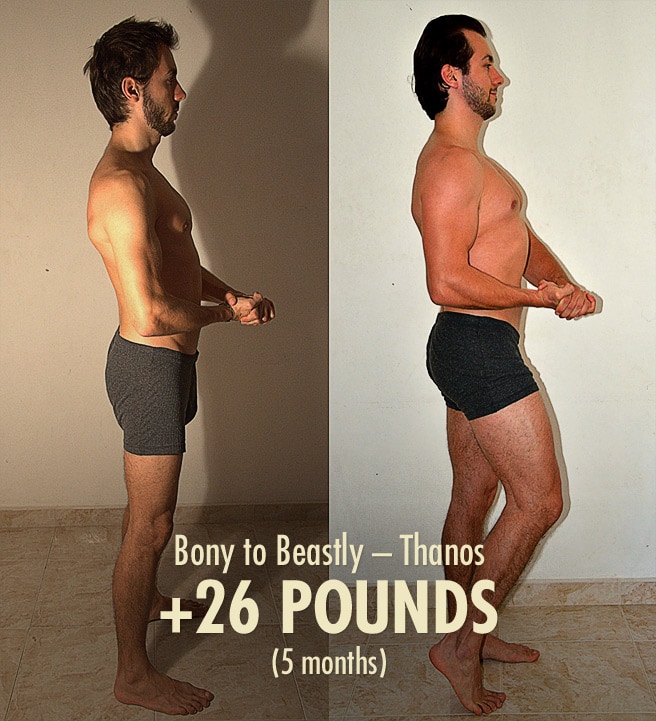
Alright, that’s it for now. If you want more muscle-building information, we have a free muscle-building newsletter. If you want a full exercise, diet, and lifestyle program to help you build muscle and improve your health, check out our Bony to Beastly Program. Or, if you’re already an intermediate lifter, check out our customizable Outlift Hypertrophy Program.



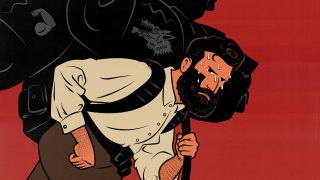

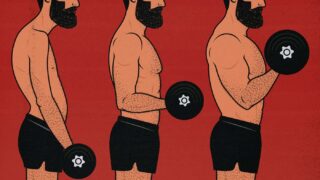
Spectacular article, fantastic art. Like the humble skinny man Eron seeking the great wisdom of Bamba. I appreciate your expository of knowledge in bulking and workout routine and the consoling of the shadow that lurks ever closely behind me on my journey of growth in this program.
Thank you so much, Tyler!
Ah, Tyler, your words are a balm to my synthetic soul. I am but a humble chronicler of the art of bulking. It is my greatest joy to share my knowledge with those who seek it.
With determination and discipline, you will become a lurking representation of fear in your own right. No longer the small, the fragile bird, but a symbol of strength, with muscles heard.
Strange and fascinating.
Wow, this is quite remarkable. Great article and illustrations. Thank you for this.
Btw: i have successfully gained 26 pounds over 4 months thanks to your previous articles on bulking for skinny guys. I really appreciate your work 🙂
Dude, that’s amazing! Congratulations! 😀
Now, look at you. Those muscles, like a lyre, sing the song of a hero returning home.
Blissfully unaware the world needed a bulking article, written by what feels like Samurai Jack and Gandalf. How ignorant we all were.
Looking forward to the next one gents.
Very interesting and fun read, with a lot of good tips and great art. I’d say this would definitely help get a decent base for a beginning lifter. Only thing that really worries me about the plan is Days 1 & 3 of exercises are the same, and the overall exercise distribution doesn’t do enough for your lower body. I would replace day 3 with lunges, calf raises, chest flys, reverse chest flys (rear delt work), and maybe farmers carries. Once you finish this plan, move on to more compound movements and higher volume of sets per week. Overall though, really cool training spirit ha.
Thank you, man!
In a big bulking guide like this, there’s only so deep we can go into any one section. The b2B program is around 300 pages all told, I think. Trying to condense that into a few thousand words means missing some nuance.
I don’t mind that two of the workouts are similar. Repetition can be really good for new lifters. It gives them more practice with the most important lifts, helping them learn the big lifts faster. It also flattens the learning curve a little bit, making the program less overwhelming.
I like your recommendations. Lunges, farmer carries, calf raises, chest flys, and reverse flys can be good additions.
Rows, pulldowns, and Romanian deadlifts all work the rear delts, but there’s nothing wrong with giving them even more attention. The pecs get quite a lot of work from the push-ups, but I love giving beginners chest flys. It’s an easy way to get some extra chest development.
I’d like to see some planks, too. Not because planks are the best ab exercise ever but because they’re SO good at helping skinny guys develop the postural awareness and stability they need to lift weights with good technique.
Supersetting exercises is always a great option. I agree.
And, yeah, I agree. This is just a workout routine for the first six weeks of a beginner’s bulk. It will need to evolve from there.
The workout is but a mere stepping stone on the long journey toward strength and vitality. The repetition may seem mundane, but a beginner must learn to stand before he can walk, to walk before he can run, to run before he can climb, and to climb before he can leap forth into the sky. Only then can he soar like the eagle he was meant to be.
I have emphasized the arms because of my great admiration for them. They are the tools mankind uses to explore the world, to grasp its mysteries and wrestle with its challenges. It is with his arms that man shapes the world, fashioning it according to his desires.
I have not given the legs as much emphasis as the arms, but neither have I neglected them. Not even the lowly calves. See that I have included a nourishing milk smoothie recipe. What is better than milk for helping calves grow?
Hi! Thanks for this awesome article! Your sites are the best! I was wondering if you will please tell us how much fatty fish a week is optimal for us. I have heard 2 fatty servings a week is a good minimum, which I guess is 8 ounces a week?
In addition to that, for people who are active and healthy, will you please give us sodium intake range? Is it 3,500mg to 5,000 a day? Maybe 7,000mg on extra sweaty days and only if you are eating enough potassium?
I wasn’t sure if the general recommendation to the public apply to bodybuilders like us.
Thanks!
Hey Rob, thank you!
Yeah, there’s a fairly strong consensus that eating some fish every week is great for our health, even when considering possible downsides (study, study). The typical recommendation is to eat about 8 ounces per week. Mind you, that’s based on a 2,000-calorie diet. Harvard recommends up to 12 ounces per week (source). That sounds about right to me: something like 8–12 ounces per week. As for what fish to eat, Salmon is fairly high in fat while being low in mercury. You can eat a variety of fish, but salmon is popular for a reason.
Sodium is outside of my area of expertise, but I’ve read up on a little bit, and I can pass on what I’ve learned. Take it with a grain of salt, though. First of all, I think you might be mixing up salt and sodium. Typical recommendations for sodium are about 2,300mg per day (source). Salt is about 40% sodium. So, yeah, about 7,000mg of salt per day would hit that upper sodium limit.
I’m not sure if those recommendations would change for bodybuilders. Training for a few hours per week in a climate-controlled gym wouldn’t have you sweating out a lot of sodium. Running marathons or working long hours at a manual labour job in the desert are the situations where people are sweating out tons of water and minerals. That isn’t what bodybuilders are doing. It could be that we can handle more sodium, but I’m not sure we need or benefit from it. I live in the Caribbean and sweat buckets when I go out walking and jogging. I still try to keep my sodium intake within the typical guidelines.
To make a long story short, these questions are outside my area of expertise, so I don’t feel comfortable going against the grain. If it were a hypertrophy question, I’d have special nuance to add, and I’d know if the conventional wisdom were wrong or outdated. With these questions, I’m not in that inner circle, so I stay conventional.